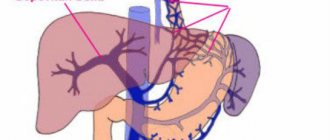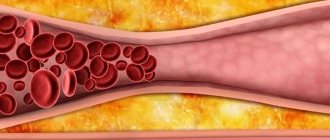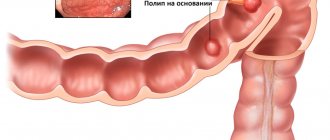Zollinger-Ellison syndrome - what is it?
This pathology is a clinical manifestation of gastrinoma, which is a hormonally active tumor.
A number of tumor variants develop aggressively with the formation of metastases. The tumor produces an excessive amount of gastrin, thereby forcing the gastric mucosa to respond to this by producing a large amount of secretion, which causes ulcers, vomiting, and diarrhea. In some cases, the pathology develops so rapidly that the need for surgery arises in less than a day.
In the 50s of the 20th century, the pathology was considered a gastric ulcer, which occurs with diarrhea. There was also excessive production of juice by the stomach, as well as a high level of gastrin in the blood.
The cause of the pathology was considered:
- Serious eating disorders;
- Excessive alcohol consumption;
- Stress.
Only then did they find out that the pathology was initiated by a tumor of a neuroendocrine nature, which, as a rule, is localized in the gastrointestinal tract.
The described syndrome is a rather rare pathology, found in 1 person in 1,000,000. Even in those who suffer from stomach ulcers, the pathology occurs in about 1%.
Most people susceptible to pathology are men 40-55 years old.
Causes of pathology
Tumor cells produce the hormonal substance gastrin, which, in turn, provokes the stomach to produce hydrochloric acid in excessive quantities.
Almost 80% of tumor cases occur in the duodenum, the rest are localized in the pancreas.
The cause of the tumor is a genetic mutation.
Neoplasia of the gastrin-producing type can also be localized in other organs, for example, in the lungs, and their manifestations can be a described pathology.
Methods for diagnosing Zollinger-Ellison syndrome
It is possible to make sure that the ulcerative process is caused by the development of a tumor in the pancreas, and not by other causes characteristic of peptic ulcers, duodenitis and gastritis, only with the help of a detailed diagnosis. Standard laboratory and instrumental studies, which are used to identify duodenal and gastric ulcers, cannot fully clarify the true picture.
Diagnosis of the syndrome includes:
- Collecting and studying anamnesis, including the patient’s life history, family history;
- Objective examination: assessment of the condition of the skin (pallor, jaundice), teeth (enamel erosion occurs in the syndrome), intestinal condition (signs of internal bleeding);
- Blood test for gastrin (given on an empty stomach) with and without a secretin test;
- Gastric acid production test.
To determine the location of damage to the mucous membrane, identify a tumor and establish other features of the disease, instrumental diagnostic methods are used:
- Esophagogastroduodenoscopy with biopsy;
- Impedance-pH-metry;
- Breath test for traces of Helicobacter bacteria;
- Ultrasound of the abdominal organs;
- Abdominal angiography (selective);
- CT scan of the abdominal cavity;
- MRI of the abdominal organs.
Additionally, consultations with specialized specialists may be required: endocrinologist, surgeon, oncologist and others.
Who is at particular risk?
It is difficult to predict the development of pathology. However, by studying nepotism, one can assume its genetic roots even in cases where the symptoms were subtle or were mistaken for the manifestation of other diseases. The pathology of the hereditary form is in most cases localized in the duodenum.
If we talk about those who were affected by the pathology by accident, then it is necessary to note its localization in the pancreas.
Hereditary neoplasms can develop as multiple tumors. The pathology is milder and oncological gastrinoma is less common. However, surgical intervention does not provide a complete cure for this form.
Diagnostics
X-ray and endoscopic examination reveal an ulcer that does not differ from that of a normal duodenal ulcer. The main laboratory criterion for Zollinger-Ellison syndrome is hypergastrinemia (the gastrin content in the blood is increased to 1000 pg/ml or more, whereas in ordinary peptic ulcer disease it does not exceed the upper limit of normal - 100 pg/ml).
The tumor itself is detected using ultrasound, computed tomography, and selective abdominal angiography. The most informative method is selective abdominal angiography with taking blood from the pancreatic veins and determining gastrin in it.
However, it is quite difficult to establish the localization of gastrinoma. In approximately half of patients with clinically and laboratory confirmed Zollinger-Ellison syndrome, the tumor cannot be found during surgery. Selective angiography can detect gastrinoma in 50%, CT - in 30%, and ultrasound - in 20% of cases.
Symptomatic manifestations
Pathology can manifest itself in various manifestations:
- Ulcers of the stomach and duodenum;
- Constant intense pain in the upper abdomen;
- Copious, semi-formed or watery stools;
- Prolonged heartburn and belching;
- Narrowing of the esophagus;
- Gastrointestinal bleeding, etc.
With the oncological nature of the pathology, a decrease in the patient’s weight is observed, and a significant decrease.
Superior vena cava syndrome (SVVC)
Symptoms of the disease
SZE causes severe abdominal pain, which usually has an atypical localization. Patients often suffer from reflux, in which stomach contents back up into the esophagus. Stomach acid causes inflammation of the mucous membranes and heartburn. A common consequence of reflux is inflammation of the larynx. Half of the patients suffer from diarrhea.
All this leads to loss of electrolytes and vitamins. Some patients experience vomiting of blood.
In addition, speaking about the symptoms of Zollinger-Ellison Syndrome , it should be noted that an excess of gastric juice inactivates lipases. Since these enzymes support digestion, the absorption of fats in the small intestine is disrupted, and they enter the large intestine, resulting in fatty changes in the consistency of stool. Sometimes the pH level in the blood increases. In rare cases, the production of parathyroid hormones increases.
Diagnostic measures
The presence of pathology can be determined by observing a multiple increase in the level of gastrin in the blood.
When performing an endoscopic ultrasound examination, you can see the tumor, but only part of it, because it is located in the wall of the duodenum.
Computed tomography and magnetic resonance imaging examinations are clearer in terms of sensitivity. The degree of this sensitivity determines the size of the tumor. In any case, it must be detected for further monitoring of development.
The effectiveness of angiography and PET is associated with a good blood supply to the tumor. The final diagnosis is announced after examination of the biopsy specimen.
As practice shows, 2/3 of tumors are not malignant; therefore, there are no metastases. Sporadic tumors are aggressive, but this is not typical for multiple endocrine neoplasia.
Pancreatic cancers usually metastasize. They can cause damage to the liver and lymph nodes of the peritoneal cavity.
Tumors of the duodenum most often affect bones, usually flat ones.
The possibility of metastases depends on the size of the tumor focus; they can cause increased pathology.
Zollinger-Ellison syndrome is a disease in which a gastrinoma, a tumor that produces gastrin, appears in the pancreas, duodenum, or other organs. Gastrin is a hormone that regulates the production of gastric juice. As a result, excessive production of gastrin and increased secretion of gastric juice (hydrochloric acid) causes ulcers of the gastrointestinal mucosa.
Zollinger-Ellison syndrome is quite rare, somewhat more common in men than in women. The disease usually develops between the ages of 20 and 50 years.
Treatment for Zollinger-Ellison syndrome involves taking medications to reduce stomach acid production and, in some cases, removing the gastrinoma.
Synonyms Russian
Gastrinoma, GE syndrome.
English synonyms
Zollinger-Ellison Syndrome, ZES.
Symptoms
The symptoms of Zollinger-Ellison syndrome are similar to those of a peptic ulcer, with the exception of diarrhea, which is usually not observed with a peptic ulcer:
- aching, “gnawing” pain, burning in the upper abdomen;
- diarrhea;
- heartburn (a feeling of discomfort and burning behind the sternum), nausea and vomiting;
- bleeding from the gastrointestinal tract;
- loss of appetite, weight loss;
- anemia;
- weakness, fatigue.
General information about the disease
Zollinger-Ellison syndrome is a disease in which a gastrinoma, a tumor that produces gastrin, appears in the pancreas, duodenum, or other organs. It occurs quite rarely, more often in men. As a rule, the disease develops between the ages of 20 and 50 years.
Gastrinoma in 80-90% of cases appears in the pancreas or duodenum. In other cases, the tumor can form in the spleen, other parts of the intestines, in the stomach, in the lymph node, in the liver, in the kidneys or in the ovary.
The pancreas is an organ located under the stomach that produces various digestive enzymes, including gastrin. The duodenum is the upper part of the small intestine, connected to the stomach.
The exact causes of tumor formation have not yet been established. The appearance of this disease is associated with multiple endocrine neoplasia (MEN), a group of hereditary syndromes caused by tumors or hyperplasia (overgrowth) of several glands of the endocrine system. Those suffering from MEN may also develop a thyroid tumor. About 25% of gastrinomas are associated with multiple endocrine neoplasia. Men suffer from MEN more often than women.
Normally, gastrin stimulates the production of hydrochloric acid in the stomach (the main component of gastric juice). It is produced in the gastric mucosa and pancreatic cells. Formed from cells that produce gastrin, the tumor releases this hormone into the blood. This leads to increased production of gastric juice, consisting of hydrochloric acid, which causes ulceration (deep inflammatory defect) of the intestinal mucosa.
Ulcers in Zollinger-Elisson syndrome are multiple, located in atypical places - at the border of the duodenum and jejunum, less often in the stomach. In a quarter of patients, ulcers are not detected.
About half of gastrinomas become cancerous over time. And although they grow slowly, the cancer can metastasize (spread beyond the primary site). Most often, gastrinomas metastasize to the lymph nodes and liver.
Over time, the tumor replaces healthy pancreatic tissue, which leads to a decrease in the production of digestive enzymes and, as a result, to insufficient digestion of fats. As a result, the patient develops diarrhea. Over time, insufficient absorption of nutrients leads to weight loss, decreased hemoglobin levels in the blood, and anemia.
Gatrinoma can lead to the following complications:
- ulcerative bleeding;
- penetration – penetration of an ulcer into surrounding organs and tissues;
- tumor metastasis to vital organs.
Who is at risk?
- People suffering from multiple endocrine neoplasia;
- relatives of persons suffering from Zollinger-Ellison syndrome.
Diagnostics
Zollinger-Ellison syndrome can be suspected if symptoms of a peptic ulcer are present if they do not go away after antiulcer therapy. In this case, the level of gastrin in the blood is determined. If its level increases significantly, studies are carried out aimed at identifying the tumor, determining its location and size.
Laboratory research:
- Gastrin. The study involves measuring the level of the hormone gastrin in the blood. Elevated gastrin levels may indicate a tumor in the pancreas or duodenum. Before the study, you should stop taking medications that reduce the production of gastric juice. Gastrin levels can fluctuate, so to obtain more accurate results, the test can be performed several times on different days. Gastrin levels can also increase in chronic gastritis, B12 deficiency anemia and other diseases.
- Measuring the acidity level of gastric juice. The technique involves inserting a probe into the stomach and then collecting gastric juice. Microprobes can also be inserted to directly measure the level of gastric acidity in the stomach. Zollinger-Elisson syndrome is characterized by a significant increase in the acidity of gastric juice.
- Provocative test with secretin (a hormone involved in the regulation of the pancreas). The study consists of intravenous administration of a secretin solution. Normally, the level of gastrin in the blood decreases, but with Zollinger-Ellison syndrome, the level of gastrin paradoxically increases significantly.
Other research methods:
- Endoscopy. The study involves a visual assessment of the gastric and intestinal mucosa to identify ulcers. To do this, a thin flexible tube with a camera is used, which is inserted into the patient's body through the throat. During an endoscopy, a biopsy may be performed - taking a tissue sample for subsequent examination under a microscope.
- Ultrasound examination (ultrasound) of the abdominal cavity, computed tomography (CT) and magnetic resonance imaging (MRI) of the abdominal cavity. These studies are carried out to visualize the tumor and determine its location and size.
Treatment
In the treatment of Zollinger-Ellison syndrome, medications are used that reduce the production of gastric juice.
Surgical tumor removal is indicated for patients without metastases. It is possible in approximately 20% of patients with Zollinger-Ellison syndrome. For multiple endocrine neoplasia, surgical treatment is not performed.
When a tumor metastasizes, chemotherapy is used to destroy tumor cells, which makes it possible to reduce the size of the tumor and reduce gastrin levels.
If the tumor has metastasized to the liver, a liver transplant may be performed.
Prevention
Prevention of Zollinger-Ellison syndrome has not yet been developed.
Recommended tests
- Gastrin
Literature
- https://emedicine.medscape.com/article/183555-overview
- Feldman, Friedman, Brandt. Sleisenger and Fordtran's Gastrointestinal and Liver Disease 9 ed. Saunders. 2010. P. 2480.
- Dan L. Longo, Dennis L. Kasper, J. Larry Jameson, Anthony S. Fauci, Harrison's principles of internal medicine (18th ed.). New York: McGraw-Hill Medical Publishing Division, 2011.
- https://www.mayoclinic.com/health/zollinger-ellison-syndrome/DS00461
Treatment
A radical method of treating pathology is tumor removal. In this case, fiber-optic diaphanoscopy of the duodenum and lateral duodenotomy are performed. As a rule, metastases are detected at the time of surgery, which means that only 30% of patients can achieve a complete cure.
The effectiveness of removing a significant part of the stomach is low: the risk of rapid recurrence is quite high.
Several decades ago, the method of total gastrectomy was widely used. Now they resort to it if conservative treatment does not give positive results and the course of the ulcer is complicated.
For therapy, drugs that reduce the level of hydrochloric acid are used. Their use may be indicated for life, since the risk of relapse is high. The doses of drugs exceed the usual ones prescribed for a standard ulcer.
In case of oncology and it is impossible to perform surgery on the tumor, chemotherapy is used.
Causes
Gastrinemia occurs when the gastrointestinal tract does not function properly. Subsequently, duodenal ulcerations of adenomas appear in one or more nodes of a dark red tone, roundish in shape, from 0.2 to 2 cm. Further uncontrolled damage to the stomach, liver, and spleen indicates the progression of the disease.
The syndrome is divided into benign (Mendelian symptom - localized pain in the projection of the ulcer) and malignant (damage to the lymph nodes of the liver and further progressive exacerbation). Zollinger-Ellison syndrome (ZES) is a rare disease. The disease can appear at any age, but is most often diagnosed in middle-aged men. Here you need to take into account genetic predisposition.
Clinics for treatment with the best prices
| Price | Total: 679 in 40 cities |
| Selected clinics | Phones | City (metro) | Rating | Price of services |
| Family Clinic in Pokrovsky | +7(499) 519..show Appointment +7(499) 519-35-86+7(499) 969-20-02+7(495) 662-58-85 | Moscow region | rating: 4.4 | 18645ք |
| Vitbiomed+ in Beregovoy Proezd | +7(499) 519..show Appointment +7(499) 519-36-63+7(495) 152-44-49 | Moscow (metro station Fili) | rating: 4.4 | 8470ք |
| MedLab on Fermskoye Shosse | +7(812) 600..show Appointment +7(812) 600-22-10+7(812) 300-07-28 | St. Petersburg (metro station Udelnaya) | rating: 4.2 | 10480ք |
| KDS Clinic on Belozerskaya | +7(495) 374..show Recording +7(495) 374-03-63 | Moscow (m. Bibirevo) | rating: 4.4 | 10738ք |
| Medicine-Plus on Volgogradsky Prospekt | +7(495) 911..show Appointment +7(495) 911-93-00+7(495) 676-10-07+7(925) 793-45-41 | Moscow (metro station Proletarskaya) | rating: 4.4 | 12080ք |
| St. Andrew's Hospitals in Korolev | +7(499) 519..show Appointment +7(499) 519-37-02+7(499) 519-35-88+7(495) 518-92-70+7(495) 518-92-72 +7(495) 518-92-80+7(495) 518-92-81 | Korolev | rating: 4.4 | 12540ք |
| Clinic of St. Petersburg State Pediatric Medical University | +7(812) 542..show+7(812) 542-93-57+7(812) 248-18-40+7(812) 295-46-23+7(812) 295-40-31 | St. Petersburg (metro station Vyborgskaya) | — | 13290ք |
| Clinic of functional disorders on Gabrichevsky | +7(495) 152..show+7(495) 152-58-35+7(495) 363-07-54+7(499) 654-08-00 | Moscow (metro station Shchukinskaya) | — | 13835ք |
| Samson on Mozhaisk highway | +7(495) 152..show Appointment +7(495) 152-58-65+7(495) 234-95-94+7(800) 234-95-95 | Moscow (metro station Kuntsevskaya) | rating: 4.3 | 13940ք |
| Sanitary expert in Bolshoi Demidovsky Lane | +7(499) 519..show+7(499) 519-37-39+7(499) 678-03-03+7(903) 722-86-02 | Moscow (metro station Baumanskaya) | — | 14400ք |
Possible complications
If therapy is not started in time, the disease can lead to dangerous consequences. These include:
- Ulcer perforation – involves the appearance of a hole in the stomach or intestines. This often leads to the development of peritonitis, which is a complex lesion of the abdominal organs.
- Stricture of the lower part of the esophagus is a significant narrowing of the lumen. This is due to constant exposure to hydrochloric acid in the stomach.
- Significant weight loss – in difficult cases, exhaustion of the body may occur.
- Impaired cardiac function - with constant diarrhea, there is a significant loss of potassium. It is this element that is responsible for the normal operation of this body.
- Metastasis of gastrinoma is the appearance of tumors in other organs. The liver is most often affected.
- Compression of the bile ducts by the formation causes jaundice and digestive disorders.
- Digestive bleeding.
Preparing for your appointment
Although your symptoms may prompt you to visit your primary care doctor, you will most likely be referred to a doctor who specializes in diseases of the digestive system (gastroenterologist) to diagnose and treat Zollinger-Ellison syndrome. You can also see an oncologist, a doctor who specializes in treating cancer.
Here's some information to help you prepare for your appointment and know what to expect from your doctor.
What can you do
- Be aware of any prior restrictions. When you make your appointment, tell your doctor's staff if you are taking any medications. Some acid-lowering drugs, such as proton pump inhibitors or H2 antagonists, may alter the results of some tests used to diagnose Zollinger-Ellison syndrome. However, do not stop taking these medications without consulting your doctor.
- Write down any symptoms you experience, including any that may seem unrelated.
- Write down key personal information, including any major stresses or recent life changes. Also write down what you know about your family's medical history.
- Make a list of all the medications, vitamins, or supplements you take.
- Write down questions to ask your doctor.
Questions to ask your doctor
For Zollinger-Ellison syndrome, some basic questions to ask include:
- What is the most likely cause of my symptoms?
- Are there any other explanations for my symptoms?
- What tests are needed to confirm the diagnosis? How should I prepare for these tests?
- What treatments are available for Zollinger-Ellison syndrome that you recommend for me?
- Are there dietary restrictions I must follow?
- How often do I need to return for follow-up appointments?
- What is my prognosis?
- Do I need to see a specialist?
- Is there a generic alternative to the medicine you are prescribing me?
- Are there any sites you recommend to learn more about Zollinger-Ellison syndrome?
- Are there any other medical problems possible because I have Zollinger-Ellison syndrome?
What to expect from your doctor
Your doctor may ask you several questions, including:
- When did you start experiencing symptoms?
- Do you have symptoms all the time, or do they come and go?
- How severe are your symptoms?
- Will anything improve your symptoms?
- Have you noticed something that is making your symptoms worse?
- Have you ever been told you have a stomach ulcer? How was it diagnosed?
- Have you or anyone in your family ever been diagnosed with multiple endocrine neoplasia type 1?
- Have you or anyone in your family been diagnosed with parathyroid, thyroid or pituitary problems?
- Have you ever been told that your blood calcium levels are high?
Share link:
- Click to share on Twitter (Opens in new window)
- Click here to share content on Facebook. (Opens in a new window)
- Click to share on Telegram (Opens in new window)
Liked this:
Like
Similar
Prognosis and prevention
The prognosis of the pathology depends on the histology of the neoplasm, its location and the presence of metastases. In most cases, the prognosis is relatively favorable. This is due to the slow growth of the tumor and the presence on the modern pharmaceutical market of a huge number of drugs that reduce gastric secretion.
The prognosis for 5-year survival depends on the patient’s initial health status, the treatment method used, and the presence of metastases in the internal organs. Death occurs when severe ulcerative lesions appear.
To avoid the development of pathology, experts recommend following the following rules:
- Healthy food,
- visit a gastroenterologist regularly,
- undergo an endoscopic examination of the gastrointestinal tract once a year,
- fight bad habits,
- avoid stress and conflict situations.
Classification
Depending on the number of tumors, gastrinomas are:
- single or solitary – diagnosed in approximately 70% of cases;
- multiple – found in every fourth patient who sought qualified help due to the presence of a gastrin-producing tumor.
Separately, it is worth highlighting hypergastrinemia - this condition is observed extremely rarely and it develops against the background of the presence of any neoplasms in the adrenal glands, esophagus or kidneys.
Depending on the location, there are:
- pancreatic gastrinoma is the most common lesion of the formation, which almost equally affects the head, body and tail of this organ;
- duodenal gastrinoma;
- gastrinoma of the stomach.
Very rarely, tumors occur in the liver and spleen, as well as in the peripancreatic lymph nodes.
Medical news
Migraine is widespread throughout the world, is better studied than other types of headaches, and is the second leading cause of years of life lost. Today in Russia more than 20 million people suffer from this disease. However, most of them do not know about their diagnosis...
The photo exhibition “Seeing the Main Thing,” dedicated to patients with psoriasis, opened on the portal of the Municipal Public Organization “Skin and Allergic Diseases” in a virtual format. “Seeing the Main Thing” is 12 portraits made using the stereo-vario technique, which allows you to see photos with and without traces of psoriasis, depending on the angle at which the visitor is looking.
Statistics show that coronary heart disease and stroke are the biggest killers worldwide. Coronavirus COVID-19 is a serious phenomenon, but at the same time we should not forget about the health of other organs. There are not many factors that affect heart health...
The Alexandrovskaya Hospital was closed for quarantine by order of the chief sanitary doctor of St. Petersburg. This is due to the fact that a 55-year-old patient with confirmed Covid-2019 coronavirus died in this hospital
In Ulan-Ude, a man with suspected coronavirus was admitted to the infectious diseases hospital. The blood samples taken for research were sent to Novosibirsk, since such tests are not performed in Ulan-Ude. The research results will be ready on the evening of January 27.
Description of treatment tactics
The oncological disease in question is dangerous due to its complications and consequences. Under the influence of negative factors, perforation of the ulcer, narrowing of the lower esophagus, and internal bleeding may occur. The list does not end there; there is still a risk of developing cachexia, cardiac dysfunction, tumor metastasis, and compression of the bile ducts.
To prevent all this, you need to consult a doctor in a timely manner. After a comprehensive examination, he will take measures to minimize the release of hydrochloric acid along with gastric juice. For this purpose, antiulcer drugs belonging to the group of proton pump inhibitors are usually used. The fact is that in the conditions of the described disease, ulcers are very resistant to standard therapy, moreover, they are prone to complications. Sometimes situations arise in which the patient's life is at risk. If conservative treatment does not produce results, the doctor decides on the need for surgical intervention. During the procedure, the tumor is completely removed.
Important! To prevent cancer or to prevent it from getting worse, you should monitor your diet and regularly undergo examination by a gastroenterologist. Do not neglect the elimination of bad habits and psycho-emotional stress.
ethnoscience
In the treatment of ulcerogenic pancreatic adenoma, the following traditional medicine recipes are used:
- Take 300 ml of aloe juice, 300 gr. liquid honey, 200 ml lemon juice, 100 ml plantain juice, ½ liter of cognac. ½ cup each of tinctures of calendula flowers, red geranium, celandine, duckweed, befungin and 50 ml of wormwood. Mix all ingredients and leave for a couple of weeks in a warm place. Filter, drink 1 tbsp. spoon three times a day,
- Pour a mug of crushed chaga mushroom with 3 mugs of cold water, leave for 4 hours, filter, store the infusion in a warm place. Brew the resulting cake with 5 cups of boiling water and leave for 2 days. Filter, mix 2 ready-made infusions with each other, take a mug three times a day,
- Combine ½ mug of crushed Kirkazon with 200 gr. honey and 1 teaspoon of sour cream, pour the finished mixture with 3 liters of warm water, leave for a couple of weeks at room temperature. Take ½ cup daily.








